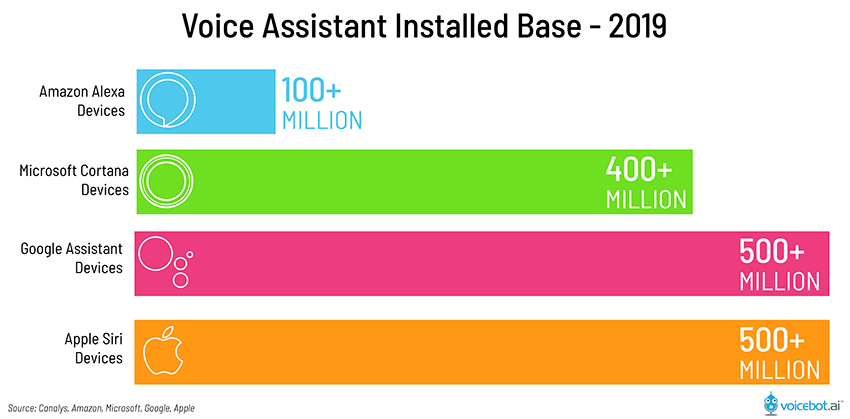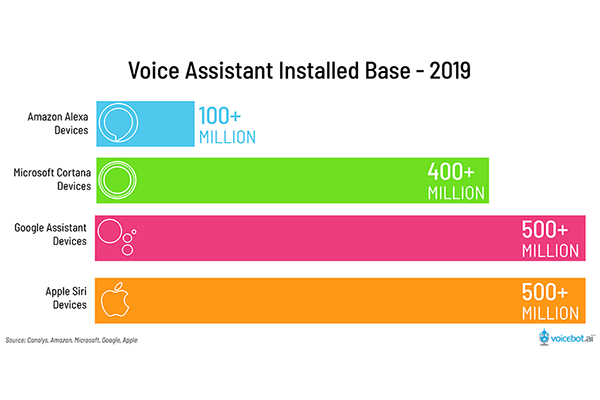Amazon Alexa is Available on 100 Million Devices – Here’s Why it is Actually More and How it Stacks Up Against Apple and Google
- Amazon senior vice president David Limp said Alexa is now available on 100 million devices.
- Apple and Google have previously stated that Siri and Google Assistant are each available on over 500 million devices.
- Device reach is an important figure but does not necessarily correlate into large numbers of monthly active users.
David Limp, Amazon senior vice president of devices and services told The Verge’s Dieter Bohn in an interview this week that Alexa is now available on over 100 million devices. That includes Amazon’s line of Echo smart speakers along with speakers and more than 150 other devices made by partners.

Apple and Google have previously stated that Siri and Google Assistant are both available on over 500 million devices globally. Most of those devices today are smartphones. Javier Soltero, a Microsoft executive said in early 2018 said that Cortana was available on 400 million devices. Most of those were presumably PCs running Windows 10. In rolling out Bixby 2.0 in November 2018, Samsung executives stressed that the voice assistant by 2020 will be able to interact with 500 million devices produced by the company annually.
Given these figures, it is not surprising that Voicebot’s Voice Assistant Consumer Adoption Report in November 2018 calculated that consumers can access voice assistants on over 1 billion devices today. The data points that most of the large tech companies are focused on is their installed base and how that provides wide access to their voice assistant. By contrast, Alexa is emerging in a wide variety of devices, many of them new to the home and the spaces we inhabit. Amazon Alexa is part of an effort to build out a new installed base of voice-addressable devices.
Access Versus Usage
Bohn hits on a core point are the beginning of his article. There is a difference between access and usage. The leading voice assistant platforms have been quick to discuss the former and less enthusiastic about the latter. There have been exceptions, but not recently. In 2017, the company said at its annual WWDC event for developers that there were 375 million monthly active Siri users. Earlier that same year, Microsoft revealed in an email to developers that, “Cortana has 145 million monthly active users across Windows, Android, iOS and Xbox.” Samsung Executive Vice President Eui-Suk Chung said at a developer conference in 2017 that there were 10 million active users of Bixby in 200 countries. However, since 2017 the leading voice assistant providers have stuck to devices with access over active users when discussing scale. Bohn comments:
“Depending on how you count, it’s either seriously impressive or a serious problem for Amazon. On the one hand, 100 million pales in comparison to the number of phones that have either Siri or Google Assistant pre-installed. On the other hand, the word “pre-installed” is the key thing to pay attention to. With Alexa devices, you could argue, consumers are making an active choice to purchase an assistant instead of just getting a default.”
The Ambient Computing Revolution
One thing Siri and Cortana don’t have is distribution through tens of millions of third-party devices. Google is aggressively courting partners to make Assistant access ubiquitous in this way, but Amazon Alexa is the leader today in non-mobile devices with direct access to a voice assistant. Amazon’s Limp told The Verge:
We have a very singular focus on this idea of an ambient user interface and where that makes the most sense.
The idea of “Alexa Everywhere” and owning the home first, the car and public spaces second is about divorcing access to computing and voice assistants from the personal device. Apple and Google have a big advantage on mobile and Microsoft has a similar stranglehold in the enterprise. However, the leverage of these companies is predominantly based on the devices they control at the operating system level. Ambient computing is about new devices and access points wherever we are as opposed to what we have. It’s an emerging segment that doesn’t have a de facto leader today and is open for competition from any company that can provide a voice interactive experience.
Alexa Has Even More Potential Reach Through its Apps
Despite the fact that Alexa is available on about one-fifth of the devices as Siri and Google Assistant, the 100 million mark is still significant. Voice assistants have little value if they are not available when you need them. They require distribution. Amazon didn’t have the luxury of a billion-user installed base of smartphone users to spread initial Alexa adoption. Apple and Google had device platforms and added voice assistants as a new feature for users. Amazon started with a voice assistant and has worked to proliferate that across devices. The first device was the Echo smart speaker, but that was always an introductory step and not a destination.
Amazon seems to be at a disadvantage on mobile, but keep in mind that there are tens of millions of users with the Alexa app on their smartphone. Those apps can now access Alexa much the same way you do with a smart speaker. This means that Alexa actually has consumer reach well beyond the 100 million devices mentioned by David Limp. Alexa doesn’t have same on-device integration on iOS as Siri has or on Android as Google Assistant does. However, much of what we expect of voice assistants is not device dependent so Alexa’s disadvantage is limited to a few domains. For everything else, Alexa is already there in mobile app form in a similar way as Google Assistant exists in the iOS ecosystem.
Eventually, we will all focus on active users. However, distribution as a key ingredient to broad adoption of a generalized voice assistant and there are few avenues to get there. The ever-present mobile device is a good starting point. Appliances are another approach. Then, there are the devices in our homes and offices at the forefront of ambient computing. That is where Amazon has built both market share and mindshare among consumers and is how Amazon could be a long-term winner in the voice assistant platform wars even without a mobile device platform.
Follow @bretkinsella Follow @voicebotai









